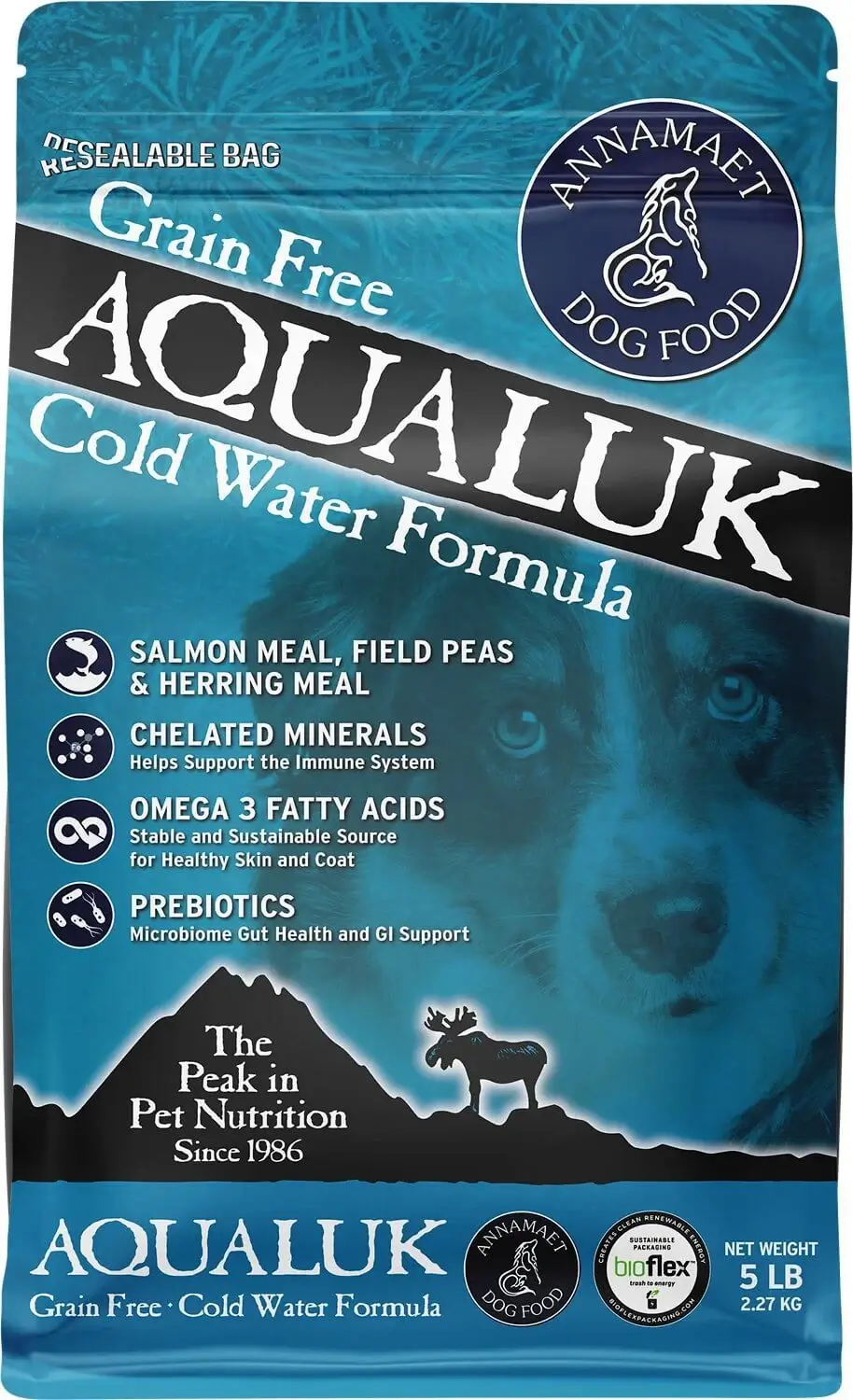
DogFoodAdvisor is reader supported See how
All reviews are 100% impartial but if you buy using links on this page, we may earn a referral fee.
Which Annamaet Grain Free Recipes Get Our Best Ratings?
Annamaet Grain Free Dog Food receives the Advisor’s top rating of 5 stars.
The Annamaet Grain Free product line includes the 7 dry dog foods listed below.
Each recipe includes its AAFCO nutrient profile when available… Growth (puppy), Maintenance (adult), All Life Stages, Supplemental or Unspecified.
Recipe and Label Analysis
Annamaet Grain Free Aqualuk Cold Water Formula was selected to represent the other products in the line for detailed recipe and nutrient analysis.
Label and nutrient data below are calculated using dry matter basis.
Annamaet Grain Free Aqualuk Cold Water Formula
Estimated Dry Matter Nutrient Content
Protein
Fat
CarbsCarbohydrates
Salmon meal, field peas, herring meal, chickpeas, potato, tapioca, canola oil, menhaden oil (preserved with mixed tocopherols), dried apples, natural flavor, marine microalgae, lecithin, dried chicory root, dl-methionine, dried blueberries, dried cranberries, salt, l-lysine, taurine, Lactobacillus acidophilus fermentation product dehydrated, vitamin E supplement, l-ascorbyl-2-polyphosphate (source of vitamin C), niacin supplement, biotin, thiamine mononitrate, l-carnitine, d-calcium pantothenate, riboflavin supplement, pyridoxine hydrochloride, vitamin A acetate, vitamin B12 supplement, vitamin D3 supplement, folic acid, choline chloride, potassium chloride, zinc proteinate, betaine anhydrous, iron proteinate, selenium yeast, copper proteinate, manganese proteinate, calcium iodate, Yucca schidigera extract
Fiber (estimated dry matter content) = 3.5%
Red denotes any controversial items
| Estimated Nutrient Content | |||
|---|---|---|---|
| Method | Protein | Fat | Carbs |
| Guaranteed Analysis | 30% | 16% | NA |
| Dry Matter Basis | 33% | 18% | 41% |
| Calorie Weighted Basis | 28% | 37% | 35% |
Ingredient Analysis
The first ingredient in this dog food is salmon meal. Because it is considered a meat concentrate, fish meal contains almost 300% more protein than fresh fish itself.
Fish meal is typically obtained from the “clean, dried, ground tissue of undecomposed whole fish and fish cuttings” of commercial fish operations.1
The second ingredient includes peas. Peas are a quality source of carbohydrates. And like all legumes, they’re rich in natural fiber.
However, peas contain about 25% protein, a factor that must be considered when judging the meat content of this dog food.
The third ingredient is herring meal, another protein-rich meat concentrate.
The next ingredient includes chickpeas, also known as garbanzo beans. Like peas, beans and lentils, the chickpea is a nutritious member of the fiber-rich legume (or pulse) family of vegetables, but they also contain about 22% protein.
The fifth ingredient is potato, which can be considered a gluten-free source of digestible carbohydrates. Yet with the exception of perhaps their caloric content, potatoes are of only modest nutritional value to a dog.
The sixth ingredient is tapioca, a gluten-free, starchy carbohydrate extract made from the root of the cassava plant.
The seventh ingredient is canola oil. Unfortunately, canola can be a controversial item. That’s because it can sometimes (but not always) be derived from genetically modified rapeseed.
Yet others cite the fact that canola oil can be a significant source of essential omega-3 fatty acids.
In any case, plant-based oils like canola are less biologically available to a dog than fish oil as a source of quality omega-3 fats.
The next ingredient is menhaden oil. Menhaden are small ocean fish related to herring. Their oil is naturally rich in the prized EPA and DHA type of omega-3 fatty acids, two high quality fats boasting the highest bio-availability to both dogs and humans.
What’s more, in their mid-depth habitat, menhaden are not as likely to be exposed to mercury contamination as is typical with deep water species.
The ninth ingredient is dried apple, a dehydrated, nutrient-rich fruit that’s also high in fiber.
From here, the list goes on to include a number of other ingredients.
But realistically, items located this far down the list (other than nutritional supplements) are not likely to affect the overall rating of this Annamaet product.
With 4 notable exceptions…
First, we find chicory root. Chicory is rich in inulin, a starch-like compound made up of repeating units of carbohydrates and found in certain roots and tubers.
Not only is inulin a natural source of soluble dietary fiber, it’s also a prebiotic used to promote the growth of healthy bacteria in a dog’s digestive tract.
Next, this food contains chelated minerals, minerals that have been chemically attached to protein. This makes them easier to absorb. Chelated minerals are usually found in better dog foods.
Additionally, we note the use of taurine, an important amino acid associated with the healthy function of heart muscle. Although taurine is not typically considered essential in canines, some dogs have been shown to be deficient in this critical nutrient.
Since taurine deficiency appears to be more common in pets consuming grain-free diets, we view its presence in this recipe as a positive addition.
And lastly, this recipe includes selenium yeast. Unlike the more common inorganic form of selenium (sodium selenite), this natural yeast supplement is considered a safer anti-cancer alternative.
Nutrient Analysis
Based on its ingredients alone, Annamaet Grain Free Dog Food looks like an above-average dry product.
The dashboard displays a dry matter protein reading of 33%, a fat level of 18% and estimated carbohydrates of about 41%.
As a group, the brand features an average protein content of 34% and a mean fat level of 15%. Together, these figures suggest a carbohydrate content of 43% for the overall product line.
And a fat-to-protein ratio of about 45%.
Which means this Annamaet product line contains…
Above-average protein. Near-average fat. And below-average carbs when compared to other dry dog foods.
Even when you consider the protein-boosting effect of the chickpeas and peas, this looks like the profile of a kibble still containing a significant amount of meat.
Our Rating of Annamaet Grain Free Dog Food
Annamaet Grain Free is a dry dog food using a significant amount of named meat meals as its dominant source of animal protein, thus receiving 5 stars.
Enthusiastically recommended.
Please note certain recipes are sometimes given a higher or lower rating based upon our estimate of their total meat content and (when appropriate) their fat-to-protein ratios.
More Top Picks
Annamaet Grain Free Dog Food Recall History
The following automated list (if present) includes all dog food recalls related to Annamaet through July.
No recalls noted.
You can view a complete list of all dog food recalls since 2009 here.
Get Free Recall Alerts
Get free dog food recall alerts sent to you by email. Subscribe to The Advisor’s recall notification list.
More Annamaet Brand Reviews
The following Annamaet dog food reviews are also posted on this website:
Compare This Dog Food
How does this brand compare with The Dog Food Advisor's most recommended brands?
A Final Word
The Dog Food Advisor does not accept money, gifts, samples or other incentives in exchange for special consideration in preparing our reviews.
However, we do receive a referral fee from online retailers (like Chewy or Amazon) and from sellers of perishable pet food when readers click over to their websites from ours. This helps cover the cost of operation of our free blog. Thanks for your support.
For more information, please visit our Disclaimer and Disclosure page.








